 In his article, “Water Flowing North of the Border: Export Agriculture and Water Policies in a Rural Community in Baja California” Christian Zlolniski uses an ethnographic analysis of how the production of fresh water in the San Quintin Valley in Baja California for consumer markets in the United States affects access and distribution of scarce water resources among different social groups in this region. In addition, he explores the connections between the neoliberal economic policies that drive the growth of the global fresh produce industry and the ways in which they shape regional power and differential access to water along class and ethnic lines. Access to clean water is one of the most basic human needs. Unfortunately, according to the International Medical Corps, one in eight people do not have access to safe drinking water. Without clean water and sanitation, public health cannot be achieved. The majority of people who do not have access to clean water are poor. Thus, unsafe drinking water, and unequal access to clean water is one of the consequences of poverty. In addition, malnutrition from unsafe drinking water or no water stunts physical and mental health. The relationship between water and poor mental health is not direct, rather it is correlated through low socioeconomic status. For example, Psychiatric conditions, which not only occur at higher rates in the poorest areas, but also cluster together, usually in disintegrating inner-city communities or agricultural communities like San Quintin Valley. While money is not a guarantor of mental health, nor does its absence necessarily lead to mental illness. However, it is generally conceded that poverty can be both a determinant and a consequence of poor mental health. Relationships between social status and various aspects of mental disorder have long been of interest to both clinicians and researchers, and a large body of research exists showing the importance of social status in understanding psychiatric illness and disability. Epidemiological studies throughout the world have demonstrated an relationship between mental illness and socioeconomic status. Further, these studies have shown that mental disorders have been consistently shown to be more common among people in lower social classes. Addressing poverty in such communities can not only give them access to clean water but can also alleviate poor mental health symptoms as well as prevent them.
In his article, “Water Flowing North of the Border: Export Agriculture and Water Policies in a Rural Community in Baja California” Christian Zlolniski uses an ethnographic analysis of how the production of fresh water in the San Quintin Valley in Baja California for consumer markets in the United States affects access and distribution of scarce water resources among different social groups in this region. In addition, he explores the connections between the neoliberal economic policies that drive the growth of the global fresh produce industry and the ways in which they shape regional power and differential access to water along class and ethnic lines. Access to clean water is one of the most basic human needs. Unfortunately, according to the International Medical Corps, one in eight people do not have access to safe drinking water. Without clean water and sanitation, public health cannot be achieved. The majority of people who do not have access to clean water are poor. Thus, unsafe drinking water, and unequal access to clean water is one of the consequences of poverty. In addition, malnutrition from unsafe drinking water or no water stunts physical and mental health. The relationship between water and poor mental health is not direct, rather it is correlated through low socioeconomic status. For example, Psychiatric conditions, which not only occur at higher rates in the poorest areas, but also cluster together, usually in disintegrating inner-city communities or agricultural communities like San Quintin Valley. While money is not a guarantor of mental health, nor does its absence necessarily lead to mental illness. However, it is generally conceded that poverty can be both a determinant and a consequence of poor mental health. Relationships between social status and various aspects of mental disorder have long been of interest to both clinicians and researchers, and a large body of research exists showing the importance of social status in understanding psychiatric illness and disability. Epidemiological studies throughout the world have demonstrated an relationship between mental illness and socioeconomic status. Further, these studies have shown that mental disorders have been consistently shown to be more common among people in lower social classes. Addressing poverty in such communities can not only give them access to clean water but can also alleviate poor mental health symptoms as well as prevent them.
-
Recent Posts
Archives
Categories
Meta





